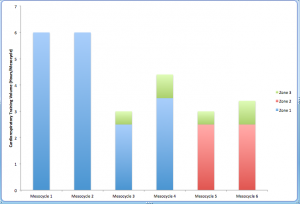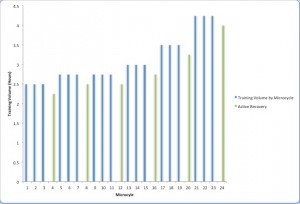This preseason periodization plan displays the frequency, intensity, time and type of training (FITT Principle) that will be incorporated over the next 6 months.
Periodization is a method used to organize specific training goals into phases. Periodization usually consists of microcyles, mesocycles and a macrocycle.
Microcycle: typically a week in length, are the smallest component of a training program, but are the most specific in detail (i.e., FITT principle).
Mesocycle: typically a month in length, are the “development” phases of a training program and usually include a specific goal or outcome.
Macrocycle: in the total training time leading up to a specific competition or event and is therefore the largest component of a training program.
Linear Periodization: progressive amounts of intensity that consists of a higher initial volume and gradually decreases. Linear periodization programs are predictable, easier to manage and safer for beginner athletes, in that it is less likely difficult to overreach or overtrain.
Sample of Periodized Program for a 20-year old female beginner athlete
Figure 1. Total Resistance Training Volume by Type and Mesocycle
Each resistance training mesocycle consists of four week training period, in which each cycle has a specific training purpose. For the above periodization, mesocycles 1-2 specifically trained hypertrophy; mesocycles 3-4 trained strength; and mesocycles 5-6 trained power with some incorporation of plyometrics. These specific mesocycles aided our client in meeting her long term (6-month) goal of playing recreational volleyball.
Hypertrophy: increases in muscular size are associated with higher training volumes and performing three or more exercises per muscle group.
Power: volume assignments for power training are typically lower than those for strength training in order to maximize the quality of exercise.
Plyometrics: rapid stretching/lengthening of muscle (eccentric) followed by shortening of the same muscle (concentric).
Classification of Exercise Intensity for Cardiorespiratory Endurance
HRmax= 220- Age
HRmax= 220-20= 200
HRR= HRmax- HR rest
HRR= 200-66= 134
Training zone= %intensity (HRR) + HR rest
Table 1. Intensity Training Heart Rate (HR) in Beats per Minute (bpm) as a Percentage of Heart Rate Reserve (HRR)
| Zone | %HRR | Actual HR (bpm) |
| 1 | 60-70 | 146-160 |
| 2 | 70-80 | 160-173 |
| 3 | 80-90 | 173-187 |
Figure 2. Total Cardiorespiratory Training by Type and Mesocycle
Each resistance training mesocycle consists of four week training period, in which each cycle has a specific training purpose. For the above periodization, mesocycles 1-2 specifically trained zone 1 (i.e., endurance); mesocycles 3-4 trained zone 1 and 3 (i.e., endurance and power bursts) ; and after the client’s foundation for endurance was built, mesocycles 5-6 trained zone 2 and 3 (i.e., speed and power bursts). These specific mesocycles aided our client in meeting her long term (6-month) goal of playing recreational volleyball.



